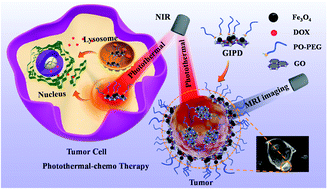Eco-friendly development of an ultrasmall IONP-loaded nanoplatform for bimodal imaging-guided cancer theranostics†
Abstract
Success in disease therapy depends on precision medicines, where development of formulations with diagnostic and therapeutic functions is quite important. In this study, multifunctional theranostics based on a magnetic graphene oxide (GO) nanohybrid (GIPD) has been developed for magnetic resonance (MR) imaging-guided chemo-photothermal therapy of cancer. The GIPD is endowed with T1/T2 MR imaging capacity via precipitation of small-sized IONP nanoparticles (8.25 ± 2.25 nm) on GO nanosheets through a mild friendly way (60 °C for 1 h, no organic solvent). The obtained nanocomposite is then non-covalently decorated with phosphine oxide polyethylene glycol to improve biosafety. The final nanohybrid effectively loads doxorubicin as the model chemotherapeutic drug and is found to have in vivo T1/T2 MR bimodal imaging functions. Both the in vitro and in vivo results demonstrate that the GO-based nanoplatform displays a good remote photothermal effect, which can damage the dense shell of solid tumor tissue, thereby facilitating the delivery of anticancer drugs into tumor cells. Therefore, this theranostic nanoplatform enables a potent combined chemo-photothermal anticancer efficacy, holding great potential for exploitation of precision cancer therapy.



 Please wait while we load your content...
Please wait while we load your content...